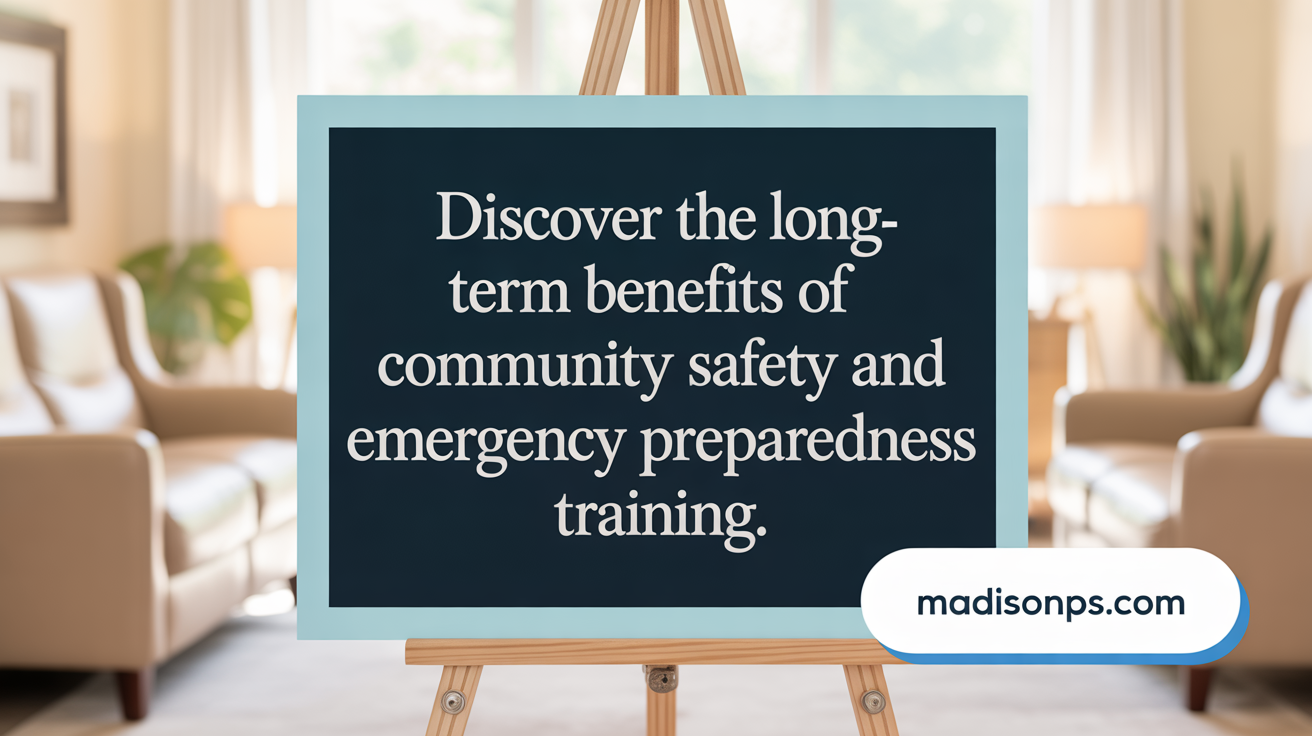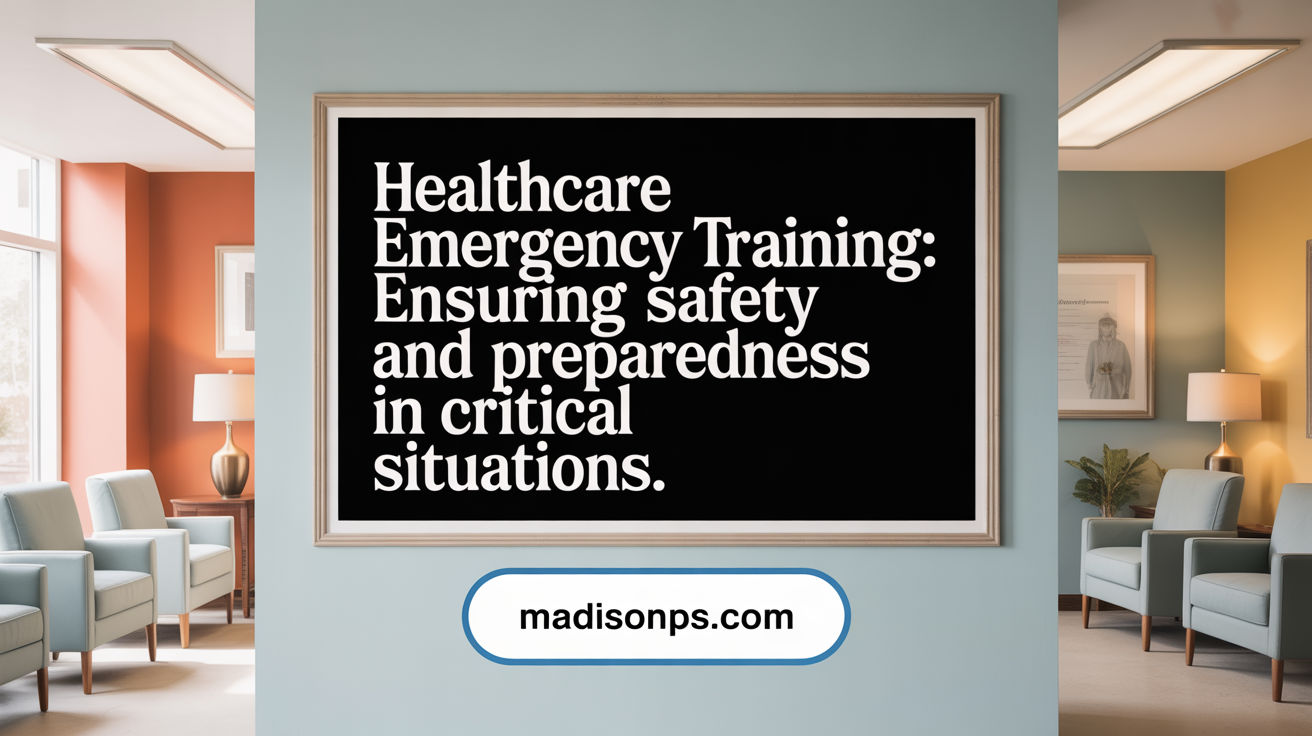Understanding the Critical Role of Training in Emergency Situations
In the face of emergencies—whether natural disasters, medical crises, or workplace accidents—the ability to respond swiftly and effectively can mean the difference between life and death. Comprehensive training in emergency response protocols equips individuals and organizations with the necessary skills, knowledge, and confidence to manage these situations, safeguard lives, and reduce harm. This article explores the significance of emergency response training, best practices for implementing it, and the continuous cycle of improvement that ensures preparedness remains robust against evolving threats.
Why Emergency Response Training Is Essential

Why is emergency response training important?
Emergency response training plays a crucial role in ensuring safety during unpredictable situations. It provides individuals with the skills needed to act quickly and effectively, whether dealing with natural disasters, accidents, or security threats. For instance, training in first aid, CPR, AED usage, fire safety, and active shooter response equips community members to render immediate assistance until professional responders arrive. Many organizations, such as Cornell University, offer these programs free of charge, helping to elevate community preparedness.
This training not only saves lives but also minimizes injuries by fostering a proactive safety culture. It raises awareness about potential hazards and familiarizes people with emergency protocols, thereby strengthening overall community resilience. When more individuals are prepared, the collective capacity to manage disasters improves, reducing chaos and confusion during actual emergencies.
Empowerment through skill acquisition
Acquiring emergency response skills empowers individuals by boosting their confidence and sense of responsibility. Trained responders can better assess situations, communicate effectively, and carry out necessary actions swiftly. This sense of empowerment encourages more active participation in safety efforts and community resilience initiatives. Long-term, well-trained staff and volunteers become valuable assets during crises, helping to stabilize situations and support affected populations.
Types of common emergency training programs
Emergency training programs cover a variety of topics tailored to specific needs. These include:
| Program Type | Focus Area | Description |
|---|---|---|
| Fire Safety | Fire prevention and extinguisher use | Training on identifying fire hazards, evacuation routes, and how to safely operate fire extinguishers |
| First Aid & CPR | Medical emergency response | Teaching lifesaving skills like wound care, CPR, and AED operation |
| Active Threat Response | Security and safety in violence situations | Preparing individuals to respond to active shooter or violent intruder incidents |
| Chemical Spill Response | Handling hazardous materials | Educating on hazard identification, containment, and decontamination procedures |
| General Emergency Protocols | Overall preparedness | Covering hazard recognition, emergency reporting, and evacuation planning |
These programs often involve active learning methods like case studies and role-playing, which are effective in adult education.
Community safety and resilience
Implementing widespread emergency response training enhances community safety and resilience. Regular drills and ongoing education keep responders prepared and aware of new protocols or hazards. Clear communication strategies and teamwork are vital, enabling coordinated responses that can effectively mitigate risks.
Organizationally, developing comprehensive emergency plans and conducting simulations are best practices. These efforts help identify gaps, refine response strategies, and ensure everyone understands their roles. Proper training and preparedness foster a safer environment where communities can recover quickly from setbacks and continue functioning with minimal disruption.
By investing in training and education, communities build a resilient foundation that promotes long-term safety, confidence, and the ability to bounce back swiftly after crises.
Benefits of Effective Emergency Response Training

What are the benefits of emergency response training?
Emergency response training is crucial for preparing individuals and organizations to handle crises effectively. It equips staff with the skills needed to follow proper emergency protocols during incidents such as fires, natural disasters, or chemical spills. Proper training significantly reduces injuries and fatalities by ensuring responders can act swiftly and correctly.
This training boosts responder confidence, enabling them to react more competently during high-pressure situations. It also emphasizes the correct use of safety resources like fire extinguishers, first aid kits, and personal protective equipment, which can be life-saving.
Another important benefit is improved coordination and communication among team members and external agencies. Clear understanding of roles and procedures minimizes confusion and increases response efficiency.
Investing in comprehensive emergency training yields long-term benefits, including higher employee morale, organizational resilience, and better preparedness. Regular drills and assessments keep skills sharp and help organizations adapt to new threats, ensuring everyone is ready when it matters most.
Training in Healthcare Emergency Procedures: A Vital Component

What is the purpose of training on emergency procedures in healthcare?
Training in emergency procedures within healthcare settings plays a crucial role in protecting both patients and staff during crises. Such training ensures that healthcare personnel can respond swiftly and effectively to various emergencies, including fires, natural disasters, hazardous material spills, or violent incidents.
Healthcare staff learn to assess patient conditions rapidly, initiate appropriate stabilization techniques, and coordinate swift transfers to higher-level care if necessary. Regular drills, including basic life support (BLS) and the proper operation of emergency equipment like defibrillators, refresh these vital skills, keeping responses sharp when emergencies arise.
Moreover, staff training covers specific hazards faced in healthcare facilities, such as environmental threats—like chemical leaks—or interpersonal violence. Training includes de-escalation tactics, collaboration with law enforcement, and understanding emergency protocols tailored to healthcare environments.
By investing in thorough emergency response training, healthcare institutions improve their ability to manage crises efficiently, reducing errors, minimizing injury, and ensuring a coordinated, swift action that ultimately saves lives.
Key Components of Effective Emergency Response Training Programs

What are the key components and content of effective emergency response training programs?
Effective emergency response training programs are designed to prepare individuals and organizations for various disaster scenarios. They start with detailed hazard and risk assessments to identify potential threats specific to the workplace or community. These assessments inform the development of tailored plans and protocols.
A critical aspect involves clarifying roles and responsibilities for all participants, including employees, emergency responders, and management. Clear communication channels and procedures help prevent confusion during crises.
Simulation exercises and drills are core elements of training. These scenario-based practices enable responders to rehearse response strategies, improve coordination, and identify weaknesses in procedures. Realistic exercises, such as fire drills or active shooter simulations, reinforce skills and build confidence.
Effective programs also emphasize resource management, including the proper utilization of safety equipment like fire extinguishers and PPE, and the use of emergency systems. Familiarity with frameworks such as the Incident Command System (ICS) and the National Response Framework (NRF) ensures structured response efforts.
To foster continuous improvement, programs incorporate regular evaluations, updates based on lessons learned, and feedback from participants. Integrating community and inter-agency coordination enhances overall responsiveness, ensuring seamless cooperation among different response entities.
Technology tools, such as communication apps and incident management systems, support efficient information sharing and decision-making.
In summary, successful emergency response training combines risk assessment, clear roles, practical exercises, resource management, structured frameworks, ongoing evaluation, and collaborative approaches—building a resilient foundation for effective disaster management.
Best Practices and Guidelines for Implementing Emergency Response Training
What are best practices and guidelines for implementing emergency response training?
Effective emergency response training hinges on comprehensive planning and continual improvement. Developing a detailed Emergency Action Plan (EAP) is a core step. This plan should identify potential hazards, assign roles to personnel, and outline specific procedures such as evacuation routes, shelter-in-place protocols, and notification systems. Having a clear, well-structured plan helps ensure everyone knows their responsibilities during a crisis.
Regular drills and simulation exercises are critical to keep response skills sharp. These activities, which include evacuations, fire drills, and scenario-based simulations, create realistic practice environments. They help identify vulnerabilities in response procedures and allow for timely updates based on lessons learned.
Training should be inclusive, covering all relevant personnel—from frontline workers to management. Key topics include hazard recognition, proper use of personal protective equipment (PPE), first aid, fire safety, and active shooter responses. Ongoing education, refreshers, and updates are necessary to maintain preparedness.
Effective communication strategies are vital. Establishing clear channels for internal and external communication ensures information flows smoothly during emergencies. Coordination with local emergency responders and agencies enhances the overall response effort, fostering cooperation and resource sharing.
Adherence to established standards such as OSHA regulations and the Incident Command System (ICS) guidelines ensures compliance and promotes a coordinated approach. These standards provide a framework for organizing response teams and managing incidents effectively.
Involving the community and external emergency partners in planning, training, and drills broadens the scope of preparedness. Community engagement fosters resilience and ensures that response efforts are well-integrated with local capabilities.
Implementing these best practices, with emphasis on regular training and continuous evaluation, builds a resilient response system capable of managing a wide range of emergencies. Such a proactive approach reduces risks, safeguards health and safety, and aligns organizational efforts with national safety standards.
The Role of Simulation Exercises and Communication Strategies
How do simulation exercises and communication strategies enhance emergency response training?
Simulation exercises are an essential part of modern disaster preparedness. They provide realistic, hands-on environments where responders can practice crucial skills such as decision-making, teamwork, and the use of emergency protocols. These exercises mimic actual disaster scenarios, allowing participants to experience real-time problem solving and coordination.
Effective communication strategies are integrated into these simulations to improve interprofessional collaboration. Clear channels of communication help responders relay information quickly and accurately, which is vital during emergencies. This coordination helps to streamline response efforts, reduce confusion, and prevent errors.
Advancements in technology, including virtual and augmented reality tools, increase the realism of training scenarios. They allow responders to practice in immersive environments, boosting confidence and resilience. These tools also enable trainees to experience a wide range of disaster situations without physical risks.
Debriefing sessions follow each simulation, where teams review their actions, discuss outcomes, and identify areas for improvement. Tailored feedback from instructors helps responders refine their skills and update response protocols, making future responses more effective.
Overall, combining simulation exercises with effective communication strategies leads to more coordinated emergency responses, quicker action, and safer outcomes. These approaches build responder confidence and ensure that teams are prepared to handle real-life disasters efficiently.
Continuous Evaluation: Sustaining Excellence in Emergency Training
Ongoing assessment plays a crucial role in maintaining and enhancing the effectiveness of emergency response training. By systematically evaluating training programs through various methods—such as questionnaires, interviews, performance reviews, and drills—organizations can identify what works well and where improvements are needed.
Monitoring the effectiveness of training in real-time and over extended periods allows program coordinators to see how well participants retain knowledge, develop skills, and adopt the right attitudes toward emergency preparedness. Data collected from these evaluations help inform targeted adjustments to training curricula, instructional methods, and resource allocation.
Implementing structured assessment phases—discovery, validation, resolution, and ongoing evaluation—ensures continuous refinement of emergency response strategies. Frameworks like FEMA’s guidance on continuous improvement can aid organizations in aligning their training efforts with evolving threats. Regular evaluations also serve as benchmarks for tracking progress over time, demonstrating tangible improvements in responder competence and confidence.
Fostering a learning culture within organizations encourages staff to view training as an ongoing process, not a one-time event. When training programs adapt based on real-world feedback and changing hazards, responders remain prepared and resilient.
In the face of new hazards like infectious diseases or climate-related disasters, regularly updated training ensures responders are equipped with the latest knowledge and skills. This proactive approach helps organizations stay ahead of emerging risks, minimizing impacts during actual emergencies.
In summary, continuous evaluation in emergency response training is essential for sustaining high standards, fostering ongoing learning, and adapting to an ever-changing landscape of threats. By leveraging data-driven insights, organizations can enhance their preparedness and protect their communities more effectively.
Addressing Vulnerabilities and Bridging Gaps Through Training
How can training help overcome response deficiencies?
Training plays a crucial role in closing gaps in disaster response. Regular drills, assessments, and updated curricula ensure responders are well-prepared to handle emergencies effectively. Programs like the NIEHS Worker Training Program (WTP) have developed comprehensive tools, brochures, and multilingual resources to ensure wide accessibility.
What measures are taken to protect responder health and safety?
Responder protection involves hazard assessments, proper use of personal protective equipment (PPE), health surveillance, and ongoing training updates. Training also emphasizes the importance of the precautionary principle, advocating preventive measures even when hazards are uncertain.
How does training improve communication and build partnerships?
Training fosters cooperation among responders, organizations, and communities. Simulations and joint exercises improve coordination and clarity, which are vital during crises. Clear communication channels and collaborative protocols help responders act swiftly and cohesively.
Why is attention to vulnerable populations essential in training?
Disaster response must address the disproportionate impacts on vulnerable groups such as the elderly, disabled, or economically disadvantaged communities. Tailored training ensures these populations receive appropriate care, and partnerships with community organizations facilitate effective outreach and support.
How are training resources made inclusive and accessible?
Multilingual materials, visual aids, and video modules enhance understanding and retention across diverse workforce groups. Ongoing education, regular drills, and universal safety practices build a resilient response system capable of addressing various hazards.
| Focus Area | Training Method | Purpose | Additional Details |
|---|---|---|---|
| Response deficiencies | Simulations, drills | Improve readiness | Practice real-life scenarios to identify response gaps |
| Protecting responders | PPE training, health surveillance | Ensure safety and health | Regular assessments and updates are vital |
| Communication | Joint exercises, protocols | Strengthen coordination | Clear channels reduce confusion |
| Vulnerable populations | Specialized outreach, tailored protocols | Minimize disparities | Community engagement programs |
| Inclusive resources | Multilingual materials, visual aids | Broaden accessibility | Use of videos and simple language enhances comprehension |
By continuously investing in comprehensive, inclusive, and practical training strategies, organizations can significantly improve disaster response outcomes, protect responder health, and ensure no community is left behind.
Emergency Response Training as a Long-Term Strategic Investment
Building employee loyalty and productivity
Ongoing emergency response training fosters a culture of safety within organizations. When employees feel confident and prepared to handle emergencies, they are more likely to remain loyal to the company. Skilled staff contribute to higher productivity, as they can respond swiftly to crises without panic.
Reducing operational risks and liabilities
Prepared employees minimize the likelihood of accidents, injuries, and legal liabilities. Regular training on hazard identification, safety procedures, and emergency protocols helps prevent incidents that can disrupt operations or lead to costly legal actions.
Ensuring regulatory compliance
Many industries are subject to safety regulations requiring regular emergency drills and training. Keeping training current satisfies legal requirements, avoids fines, and demonstrates a company’s commitment to worker safety.
Business continuity and reputation management
Effective emergency preparedness reduces downtime during disasters, protecting revenue and customer trust. Organizations that invest in training and crisis management build a reputation for responsibility and resilience, fostering stakeholder confidence.
The role of comprehensive crisis management plans
A well-developed crisis management plan guides organizations through each phase of an emergency, from planning to recovery. Training employees on these plans ensures coordinated action, quick decision-making, and minimized impact of emergencies.
| Benefit | Description | Supporting Impact |
|---|---|---|
| Employee loyalty | Training encourages staff retention and morale | Better response, fewer turnovers |
| Risk mitigation | Reduces accidents and legal risks | Lower insurance premiums and liabilities |
| Regulatory adherence | Meets legal safety standards | Fines avoided, compliance maintained |
| Business resilience | Keeps operations running smoothly | Customer trust and brand reputation |
| Strategic readiness | Enhances disaster recovery capabilities | Faster recovery and less financial damage |
Continued investment in emergency response training not only protects personnel and assets but also reinforces an organization’s overall resilience. It is an essential component of a strategic approach to managing risks and maintaining long-term operational excellence.
Strengthening Preparedness Through Ongoing Training and Collaboration
Training in emergency response protocols is a foundational pillar of effective preparedness and disaster mitigation. By imparting critical skills, fostering confidence, and encouraging teamwork, such training transforms potential chaos into coordinated action during crises. Success lies not only in initial instruction but also in continuous evaluation, simulation practice, and adaptive improvements reflecting evolving challenges. Moreover, addressing responder safety and community inclusivity ensures no one is left behind. Investing in comprehensive emergency response training ultimately safeguards lives, protects assets, and fortifies organizational resilience, making it an indispensable component of modern crisis management strategies.
References
- Training Can Overcome Issues in Disaster Response - PMC
- Importance of Emergency Readiness Training in the Workplace
- Benefits of Emergency Response Training | First 5 MinutesMeta
- Workplace Emergency Response Training: Why It Matters - Eddy
- What role does training play in Emergency Response Planning?
- Employee Training | Ready.gov
- The Importance of Efficient Emergency Response and ...
- Evaluating the effectiveness of an emergency preparedness training ...
- Emergency Preparedness Training
